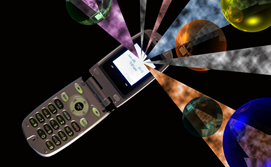The Madrid-based company SIDSA, in collaboration with the University of Seville, is working on the development of one of the first integrated receivers for the new television system DVB-SH (Digital Video Broadcasting – Satellite services to Handhelds).
The television system DVB-SH will provide data and multimedia content to personalized handhelds such as mobile phones and PDAs (Personal Digital Assistants).
This new system is able to receive the signal while moving, both in the case of mobile telephones as well as during transportation (high speed trains, buses). In order to accomplish this, the DVB-SH uses a satellite to reach a high number of users over an extensive geographic area. However, in cases where there is not good satellite coverage due to shadows from buildings and bridges, the service provides small terrestrial repeaters. “The mobile devices possessing the receiver have small screens and need to receive less information, but the reception in movement requires a transmission system that is very robust”, explains one of the researchers on the project, Vicente Baena Lecuyer.
Further, the DVB-SH system provides an alternative method based on the extensive use of memory. That is, the receiver is not continually receiving the television signal, but rather has intermittent stoppages, during which the circuits are turned off and do not consume energy, without affecting the quality of the image. “This system involves less energy consumption, which is key for mobiles and other devices that have limited battery power”, specified Lecuyer.
SIDSA is a comprehensive provider of technologies for digital terrestrial and mobile TV. Headquartered in Madrid, the company has offices in Zaragoza, Dubai, Hong Kong, Moscow and San Francisco. Its clients include global companies such as Axion, RAI (Italy), OTB (Russia), RTVE (Spain) and Telefónica, among others.
